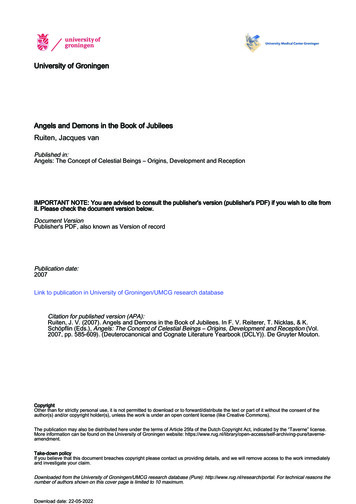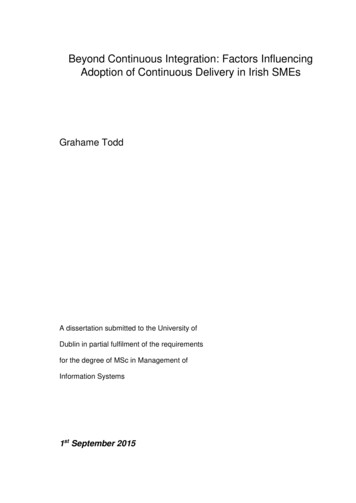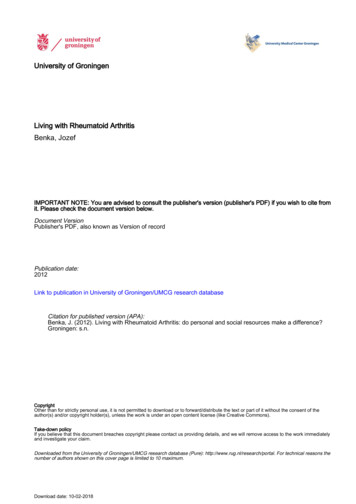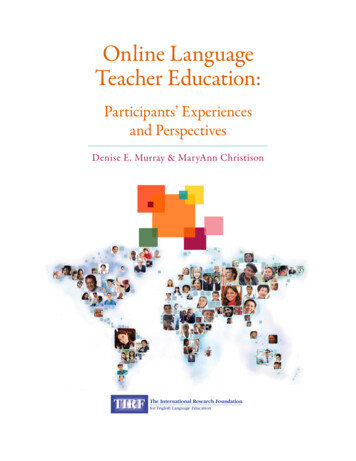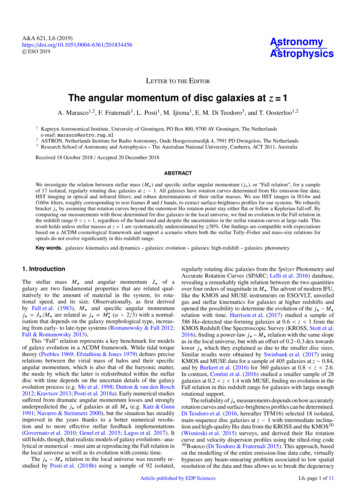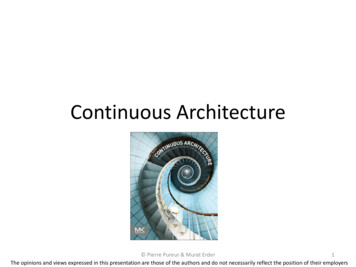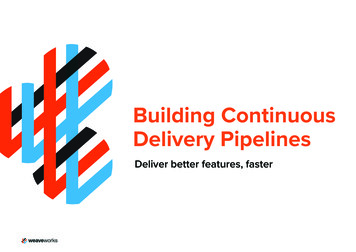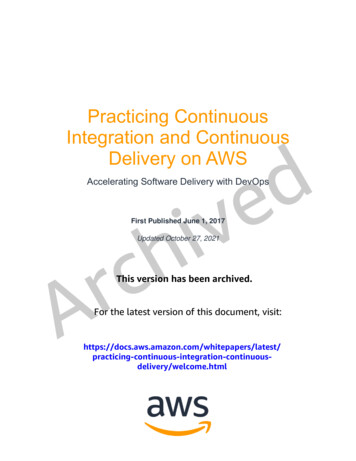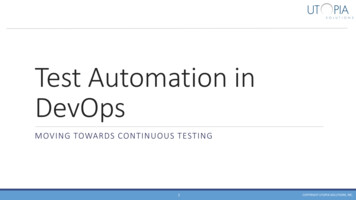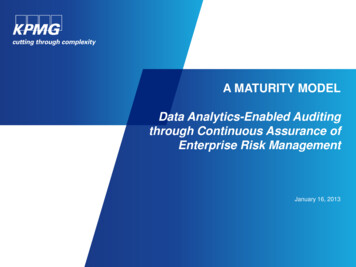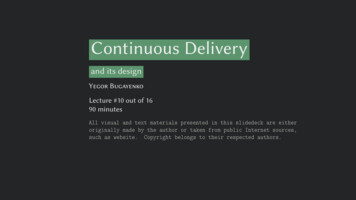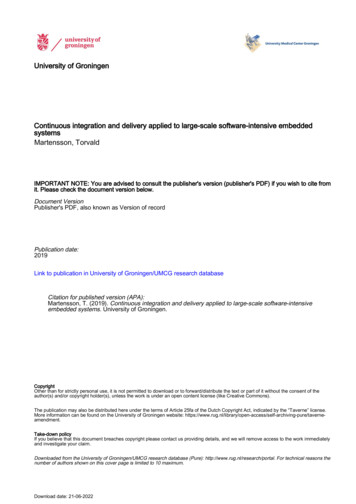
Transcription
University of GroningenContinuous integration and delivery applied to large-scale software-intensive embeddedsystemsMartensson, TorvaldIMPORTANT NOTE: You are advised to consult the publisher's version (publisher's PDF) if you wish to cite fromit. Please check the document version below.Document VersionPublisher's PDF, also known as Version of recordPublication date:2019Link to publication in University of Groningen/UMCG research databaseCitation for published version (APA):Martensson, T. (2019). Continuous integration and delivery applied to large-scale software-intensiveembedded systems. University of Groningen.CopyrightOther than for strictly personal use, it is not permitted to download or to forward/distribute the text or part of it without the consent of theauthor(s) and/or copyright holder(s), unless the work is under an open content license (like Creative Commons).The publication may also be distributed here under the terms of Article 25fa of the Dutch Copyright Act, indicated by the “Taverne” license.More information can be found on the University of Groningen website: ing-pure/taverneamendment.Take-down policyIf you believe that this document breaches copyright please contact us providing details, and we will remove access to the work immediatelyand investigate your claim.Downloaded from the University of Groningen/UMCG research database (Pure): http://www.rug.nl/research/portal. For technical reasons thenumber of authors shown on this cover page is limited to 10 maximum.Download date: 21-06-2022
Chapter 10Exploratory Testing of Large-Scale Systems – Testing inthe Continuous Integration and Delivery PipelineThis chapter is published as: Mårtensson, T., Ståhl, D. and Bosch, J. (2017). Exploratory testingof large-scale systems – Testing in the continuous integration and delivery pipeline. 18thInternational Conference on Product-Focused Software Process Improvement, PROFES 2017,pp. 368-384.Abstract: In this paper, we show how exploratory testing plays a role as part of a continuousintegration and delivery pipeline for large-scale and complex software products. We propose atest method that incorporates exploratory testing as an activity in the continuous integration anddelivery pipeline, and is based on elements from other testing techniques such as scenario-basedtesting, testing in teams and testing in time-boxed sessions. The test method has been validatedduring ten months by 28 individuals (21 engineers and 7 flight test pilots) in a case study wherethe system under test is a fighter aircraft. Quantitative data from the case study company showsthat the exploratory test teams produced more problem reports than other test teams. Theinterview results show that both engineers and test pilots were generally positive or very positivewhen they described their experiences from the case study, and consider the test method to be anefficient way of testing the system in the case study.10.1 IntroductionExploratory testing was coined as a term by Cem Kaner in the book “Testing ComputerSoftware” 1988 (Kaner 1988), and was then expanded upon as a teachable disciplineby Kaner, Bach and Pettichord in their book “Lessons Learned in Software Testing” in2001 (Kaner et al. 2001). The test technique combines test design with test execution,and focuses on learning about the system under test.Different setups exist for planning, execution and reporting exploratory testing.Testing can be organized as charters (Gregory and Crispin 2015, Hendrickson 2013) ortours (Gregory and Crispin 2015, Whittaker 2010) which are conducted as sessions(Gregory and Crispin 2015, Hendrickson 2013) or threads (Gregory and Crispin 2015).Janet Gregory and Lisa Crispin describe the test technique (Gregory and Crispin 2015)with the following words: “Exploratory testers do not enter into a test session withpredefined, expected results. Instead, they compare the behavior of the system againstwhat they might expect, based on experience, heuristics, and perhaps oracles. Thedifference is subtle, but meaningful.” The core of the test technique is the focus onlearning, shown in for example Elisabeth Hendricksson’s definition (Hendrickson2013) of exploratory testing: “Simultaneously designing and executing tests to learnabout the system, using your insights from the last experiment to inform the next”.Coevally with the evolution of exploratory testing, continuous integration and othercontinuous practices emerged during the 1990s and early 2000s. The exact moment for184
the birth of each practice is up for debate. Continuous integration is often referred to asa term coming from either Kent Beck’s book “Extreme Programming” (Beck 1999) in1999 or Martin Fowler’s popular article in 2006 (Fowler 2006), and the term continuousdelivery seems to have been established by Jez Humble and David Farley in the book“Continuous Delivery” in 2010 (Humble and Farley 2010). Automated testing isdescribed as a corner stone of continuous practices, and automated tests tend to be thefocus when test activities are assembled to a continuous integration and deliverypipeline (shown in Figure 37). This pipeline splits the test process into multiple stages,and is described with different terminology by Duvall (2007) as “stage builds”, byLarman and Vodde (2010) as “multi-stage CI system” or by Humble and Farley (2010)as the “deployment pipeline” or “integration pipeline”. Humble and Farley (2010)include exploratory testing in the final stage before release to the customer. We believethat exploratory testing also can play an important role early in the integration flow,especially when developing large-scale systems with many dependencies between thesubsystems.Based on this, the topic of this paper is to answer the following research question:How can exploratory testing be used in the continuous integration and delivery pipelineduring development of large-scale and complex software products?The contribution of this paper is three-fold. First, it presents a test method for largescale and complex software products. Second, the paper shows how exploratory testingplays a role as part of a continuous integration and delivery pipeline for large-scale andcomplex software products. Third, it provides quantitative data and interview resultsfrom a large-scale industry project. The remainder of this paper is organized as follows.In the next section, we present the research method. This is followed in Section 10.3 bya study of related literature. In Section 10.4 we present the test method, followed byvalidation in Section 10.5. Threats to validity are discussed in Section 10.6. The paperis then concluded in Section 10.7.Figure 37: An example of a continuous integration and delivery pipeline(including exploratory testing), showing the flow of test activities that followsa commit of new software.10.2 Research MethodThe first step to answer the research question stated in Section 10.1 was to conduct asystematic literature review (according to Kitchenham (2004)), which is presented inSection 10.3. The question driving the review was ”Which test methods related to185
exploratory testing and testing of large-scale and complex systems have been proposedin literature?”The test method for exploratory testing of large-scale systems was developed basedon related published literature and experiences in the case study company. The testmethod was validated using the following methods to achieve method and datatriangulation (Runeson and Höst 2009):· Systematic literature review: Comparison of the test method and related work foundin literature.· Validation interviews: Interviews with 18 engineers and 7 flight test pilots who usedthe test method during ten months.· Analysis of quantitative data: Exploratory analysis of quantitative data (problemreports and time used in the test rig) retrieved from the case study.Interviews were held with 25 of the 28 individuals who were participating in the testactivity in the case study. The remaining three had in two cases changed jobs, and wasin one case on parental leave. The interviews were conducted as semi-structuredinterviews, held face-to-face or by phone using an interview guide with pre-definedspecific questions. The interview questions were sent to the interviewee at least one dayin advance to give the interviewee time to reflect before the interview. The questionsin the interview guide were:· How would you describe your experiences from [name of the test activity in theproject]?· What did you like or not like about The planning meetings? The briefings before testing? The test sessions in the rig? The debriefings after testing?· What do you like or not like about [name of the test activity in the project] comparedto other types of test activities?· Are you interested in participating in this type of activity again?The interview results were analyzed based on thematic coding analysis as describedby Robson (2016) (pp. 467-481), resulting in three main themes corresponding to thecharacteristics of the test method (each supported by statements or comments bybetween 15 and 20 of the interviewees). The process was conducted iteratively toincrease the quality of the analysis. Special attention was paid to outliers (intervieweecomments that do not fit into the overall pattern) according to the guidelines fromRobson (2016), in order to strengthen the explanations and isolate the mechanismsinvolved.Detailed data on e.g. types of scenarios selected by the test teams, types of issuesfound during the test sessions or detailed interview results are not included in thisresearch paper due to non-disclosure agreements with the case study company.186
10.3 Reviewing Literature10.3.1 Criteria for the Literature ReviewTo investigate whether solutions related to the research question have been presentedin published literature, a systematic literature review (Kitchenham 2004) wasconducted. A review protocol was created, containing the question driving the review(”Which test methods related to exploratory testing and testing of large-scale andcomplex systems have been proposed in literature?”) and the inclusion and exclusioncriteria. The inclusion criterion and the exclusion criterion for the review are shown inTable 21.Inclusion criterionYieldPublications matching the Scopus search string TITLE-ABS-KEY( "exploratory testing" AND software ) onMarch 27, 201752Exclusion criterionRemainingExcluding duplicates, conference proceedings summaries and publicationswith no available full-text39Table 21:Inclusion and exclusion criteria for the literature review.To identify published literature, a Scopus search was conducted. The search wasupdated before writing this research paper, in order to include the state-of-the-art. Thedecision to use only one indexing service was based on the fact that we in previouswork have found Scopus to cover a large majority of published literature in the field,with other search engines only providing very small result sets not already covered byScopus.10.3.2 Results from the Literature ReviewAn overview of the publications found in the systematic literature review is presentedin Table 22. The review of the 39 publications retrieved from the search revealed thatfive of the publications were not directly related to exploratory testing. These papersuse the term “exploratory testing” as a keyword without a single mention in the articleitself or only mentioning it in passing. In addition to that, one of the papers was a posterwhich contained the same information as another paper found in the search.187
Topic of the publicationsNot relevantPosterMethods/toolsEffectiveness and efficiency of test methodsHow exploratory testing is usedReporting experiencesSummaryNumber of papers5110145439Table 22: An overview of the publications found in the systematic literaturereview.Ten of the papers were related to methods and tools, typically combining two testtechniques such as model-based testing and exploratory testing (Frajtak et al. 2017,Frajtak et al. 2016, Gebizli and Sözer 2016, Schaefer and Do 2014, Schaefer et al.2013). Two papers proposed different approaches to combine script-based testing andexploratory testing (Shah et al. 2014a, Rashmi and Suma 2014) and one paper describedhow to extract unit tests and from exploratory testing (Kuhn 2013). One paper discussed“guidance for exploratory testing through problem frames” (Kumar and Wallace 2013)and finally one paper investigated the feasibility of using a multilayer perceptron neuralnetwork as an exploratory test oracle (Makando et al. 2016).Fourteen of the publications discussed the effectiveness and efficiency of differenttest methods. Two of those were systematic literature reviews (Thangiah and Basri2016, Garousi and Mäntylä 2016a) and one combined a systematic literature reviewand a survey (Ghazi et al. 2015). Eight papers (Itkonen et al. 2016, Afzal et al. 2015,Itkonen and Mäntylä 2014, Shah et al. 2014b, Shah et al. 2014c, Prakash andGopalakrishnan 2011, Itkonen et al. 2007, Do Nascimento and Machado 2007)compared exploratory testing and scripted testing (also referred to as test case basedtesting or confirmatory testing). The comparisons were based on either true experimentsor experiences from industry projects. Sviridova et al. (2013) discuss effectiveness ofexploratory testing and proposes to use scenarios. Micallef et al. (2016) discuss howexploratory testing strategies are utilized by trained and not trained testers, and howthis affect the type of defects the testers find. Raappana et al. (2016) report theeffectiveness of a test method called “team exploratory testing”, which is defined as away to perform session-based exploratory testing in teams.Five papers describe in different ways how exploratory testing is used by the testers,based on either a true experiment (Shoaib et al. 2009), a survey (Pfahl et al. 2014),video recordings (Itkonen et al. 2013) or interviews (Itkonen et al. 2009, Itkonen et al.2005). Itkonen and Rautiainen (2005), Shoaib et al. (2009) and Itkonen et al. (2013)describe how the tester’s knowledge, experiences and personality are important whileperforming exploratory software testing in industrial settings. Itkonen et al. (2009)present the results of a qualitative observation study on the manual testing practices,and presents a number of exploratory strategies: “User interface exploring”, “Exploringweak areas”, “Aspect oriented testing”, “Top-down functional exploring”, “Simulatinga real usage scenario”, and “Smoke testing by intuition and experience”.188
Finally, four papers (Gouveia 2016, Suranto 2015, Moss 2013, Pichler and Ramler2008) report experiences from exploratory testing in industry, but without presentingany quantitative or qualitative data as validation. Suranto (2015) describes experiencesfrom using exploratory testing in an agile project. Pichler and Ramler (2008) describesexperiences from developing and testing a visual graphical user interface editor, andtouches upon the use of exploratory testing as part of an iterative development process.Gouveia (2016) reports experiences from using exploratory testing of web applicationsin parallel with automated test activities in the continuous integration and deliverypipeline.In summary, we found no publications that discussed exploratory testing in thecontext of large-scale and complex software system. Some publications touched ontopics related to the subject, such as iterative development and continuous integration(which are commonly used during development of large-scale and complex softwaresystems).10.4 Exploratory Testing of Large-Scale Systems10.4.1 Characteristics of the Test MethodThe test method for exploratory testing of large-scale systems is based on relatedpublished literature and experiences from the case study company. In this case,exploratory testing is used to test a large-scale and complex system, which may consistof a range of subsystems that are tightly coupled with a lot of dependencies.The motivation behind developing the test method was an interest in the case studycompany to increase test efficiency, and to find problems related to the integration ofsubsystems earlier in the development process. The transformation to continuousdevelopment practices implies a transformation from manual to automated testing. Thisrequires large investments, both a large initial investment in implementing automatedtest cases and later costs for maintaining the test cases to keep up with changes in thesystem under test. For test activities that is likely to not remain static (the samespecification is run over and over again) it is an alternative to utilize the flexibility ofexperienced engineers in manual test activities.The test method is designed to complement automated testing in the continuousintegration and delivery pipeline, and to provide different feedback and insights thanthe results from an automated test case. The characteristics of the test method are:· Exploratory testing as an activity in the continuous integration and deliverypipeline: Testing is conducted with an exploratory approach where the testerssimultaneously learn about the system’s characteristics and behavior. Testing is doneregularly on the latest system build, which has passed the test activity in thepreceding step in the continuous integration and delivery pipeline.· Session-based testing in teams with experienced engineers representing differentsubsystems: Testing is conducted in time-boxed sessions by teams of hand-pickedexperienced engineers, representing the different subsystems of the product. If the189
size or complexity of the system under test cannot be covered by a single team, thetest scope can be split between several teams.· Scenario-based testing with an end-user representative as part of the test team:Testing is conducted in scenarios, which represent how the product will be used bythe end-user. An end-user representative is participating in both planning and testexecution, securing that the scenarios are reflecting appropriate conditions.The characteristics of the test method are in different ways described or touchedupon in published literature. Exploratory testing has been described (at least briefly) inthe context of agile or iterative development (Gregory and Crispin 2015, Suranto 2015,Pichler and Ramler 2008) and one report describes how exploratory testing is used inthe “continuous integration pipeline” (Gouveia 2016). Exploratory testing is oftencombined with the use of sessions (Gregory and Crispin 2015, Hendrickson 2013, Afzalet al. 2015, Raappana et al. 2016, Itkonen et al. 2013) and the concept of testing inteams has been described (Raappana et al. 2016) or at least touched upon (Gregory andCrispin 2015). There are also publications that enhance the importance of experienceand knowledge (Shoaib et al. 2009, Itkonen et al. 2013, Itkonen and Rautiainen 2005).The use of scenarios is also described in different ways (Gregory and Crispin 2015,Whittaker 2010, Sviridova et al. 2013, Itkonen et al. 2009), but not specifically with anend-user representative as part of the test team.10.4.2 Using the Test MethodThe test team work together in planning workshops, test sessions and debriefingmeetings (shown in Figure 38).Figure 38: The flow between planning meetings, test sessions and debriefingmeetings.At the planning meeting, the test team discusses ideas for testing that could result infinding uncovered problem areas. The team members prioritize and group the test ideasinto scenarios, which could be executed during a test session. A scenario is a chain ofevents that could be introduced by either the product’s end-user, derive from a problemin the product’s software or hardware systems, or be coming from other systems or theenvironment where the product is operated (e.g. change of weather if the product is acar). The test team is monitoring the reports from other test activities in the continuous190
integration and delivery pipeline, in order to follow new or updated functions or newproblems that have been found which could affect the testing.During the test session, the scenarios are tested in a test environment which is asproduction-like as possible. The test environment must also be equipped so that the testteam is able to test fault injection and collect data using recording tools. Before the testsession the team must also decide on test approaches for the planned test sessions:Should the team observe as many deviations as possible or stop and try to find rootcauses? Should the team focus on the intended scope or change the scope if other issuescome up?The debriefing meeting is used by the team to summarize the test session. Theresponsibility to write problem reports or follow up open issues found in the test sessionis distributed among the team members. The team should consider if a problem shouldhave been caught at a test activity earlier in the pipeline, and report this in an appropriateway. Decisions are made if the tested scenarios should be revisited at the next sessionor not. The team should also discuss how team collaboration and other aspects of testefficiency could be improved.10.5 Validation10.5.1 The Case StudyThe case study company is developing airborne systems and their support systems. Themain product is the Gripen fighter aircraft, which has been developed in severalvariants. Gripen was taken into operational service in 1996. An updated version of theaircraft (Gripen C/D) is currently operated by the air forces in Czech Republic,Hungary, South Africa, Sweden and Thailand. The next major upgrade (Gripen E/F)will include both major changes in hardware systems (sensors, fuel system, landinggear etc.) and a completely new software architecture.The test method described in Section 10.4 was applied to a project within the casestudy company for ten months. The system under test was the aircraft system withfunctionality for the first Gripen E test aircraft, which was tested in a test rig. The testpilot was maneuvering the aircraft in a cockpit replica, which included real displays,panels, throttle and maneuvering stick. In the rig the software was executing on thesame type of computers as in the real aircraft. The aircraft computers were connectedto an advanced simulation computer, which simulated the hardware systems in theaircraft (e.g. engine, fuel system, landing gear) as well as a tactical environment. Avisual environment was presented on an arc-shaped screen. The test teamcommunicated with the pilot from a test leader station in a separate room. From the testleader station the tester could observe the pilot’s displays and the presentation of theaircraft’s visual environment. The test team could also observe the behavior of thesoftware in the aircraft computers and inject faults in the simulator during flight (e.g.malfunction of a subsystem in the aircraft).Continuous integration practices such as automated testing, private builds andintegration build servers were applied in the development of software for the Gripen191
computer systems. When a developer committed new software to the mainline, the newsystem baseline was tested in multiple stages in a pipeline similar to the example shownin Figure 37. All test activities on unit, component and system level which wereeffectuated up to weekly frequency were automated tests, followed by exploratorytesting and other manually executed test activities.Testing was conducted in sessions, starting with four hours per session which aftertwo months was changed to three hours. The testing started with two teams, followedby a third team after a month. The teams tested at a frequency of one test session perweek for two weeks out of three, meaning that generally two of the three teams testedevery week. The testers were handpicked from the development teams, all being seniorengineers representing different subsystems in the aircraft. A test pilot (from the flighttest organization) was maneuvering the aircraft in the simulator. The engineers (in total21 individuals) were allocated to the three test teams, each of which focused on onecluster of subsystems in the aircraft. The last two months the teams were merged to onetest team, due to that no new functions were introduced and not so many new problemswhere found during the test sessions.10.5.2 Validation InterviewsThe interviewed 18 engineers who participated in the test activity were generally veryexperienced, all with many years of experience from industry software development.The interviewed 7 pilots were all employed as flight test pilots, with training frommilitary pilot schools and experience from many years of service in both the air forceand as test pilots in the industry. Both engineers and test pilots were generally positiveor very positive when they described their experiences. “Relevant and good testing”, toquote one of the test pilots. One of the engineers described it with the following words:“It was fantastic! We identified a lot of problems. And we learned how the systemworked.”The three test teams used the way of working described in Section 10.4 with planningmeetings, test sessions and debriefing meetings. The interviewees described that they“built a backlog” of things to test at the planning meetings, which was then used duringthe upcoming test sessions. The planning meetings were described with words as“creative” or “at least as interesting as the testing itself”. Interviewees from one of thetest teams described that they at first did very little preparations before the testing,resulting in some unprepared and inefficient test sessions. This changed when the teamfocused more on the planning meetings.All teams held a short briefing (10-15 minutes) right before the test session, in orderto go through the program for the test session. This was appreciated by both engineersand test pilots, as it gave everyone a picture of what would happen. During the briefingroles and responsibilities were also clearly distributed (communicating with the pilot,taking notes etc.). The testing itself was generally described as efficient, whereengineers and the test pilot were working together as a team. One voice asked for bettertools for some of the fault injection procedures, and someone else asked for betterrecording capabilities. After the test session the team had a short debriefing, with thepurpose to summarize the findings and decide who was to write problem reports or192
further examine open issues. The teams often also had a follow-up meeting the day afterthe test, focusing on improving test efficiency and ways of working.Both the engineers and the test pilots were generally very generous with commentsand thoughts regarding their experiences from the test activities. Many engineersdescribed their experiences with a lot of enthusiasm, and in some cases even referringto the testing as “great fun”. The experiences shared by the interviewees aresummarized in themes corresponding to the characteristics of the test method:· Exploratory testing as an activity in the continuous integration and delivery pipeline· Session-based testing in teams with experienced engineers representing differentsubsystems· Scenario-based testing with an end-user representative as part of the test teamExploratory testing as an activity in the continuous integration and deliverypipeline: Both engineers and test pilots described the benefits with exploratory testing,where the test teams not plainly follow the instructions in a test case step by step. Asone interviewee described it: “We could test according to the ideas we had. We wantedto understand the system that we were building and to find the weaknesses in thesystem”. A few interviewees also described that they during this test activity werelooking for the root cause of the problems that were found, whereas they in other testactivities just wrote down a brief description of the problem. Besides talking about thebenefits from the higher level of freedom, many engineers also described the need forstructure and discipline. A field of improvement seemed to be communication of theresults from other test activities in the continuous integration and delivery pipeline.Several interviewees described situations where the team was not sure if a problem wasalready known, or even if a function was complete or still under development.However, according to the interviewees the synchronization with other test activitiesimproved over time.Session-based testing in teams with experienced engineers representing differentsubsystems: Almost all engineers described benefits from testing in teams. Accordingto the interviewees, many of the questions that came up at a test session could be solveddirectly during the test session. Another engineer described that “the quality of theproblem reports improves if there are people from different subsystems participating atthe test”. The engineers described that they were “learning about the system” and“learning about other subsystems”. A few voices talked about the importance of havingthe right people onboard, referring to personality as well as knowledge and experiencefrom the different subsystems of the product. To have a team of six or up to eight peopleparticipating during the same test session could also be challenging. Severalinterviewees described that it sometimes was difficult to see what was going on at thedisplays, and it was important that the test leader was good at involving all teammembers in the test process.Scenario-based testing with an end-user representative as part of the test team:Almost all interviewees described or touched upon that scenarios was a good way totest the complete system. Both engineers and test pilots described that most of the othertest activities focused on a subsystem in the aircraft, whereas this test activity focusedon the complete aircraft. The interviewees seemed t
1999 or Martin Fowler's popular article in 2006 (Fowler 2006), and the term continuous delivery seems to have been established by Jez Humble and David Farley in the book "Continuous Delivery" in 2010 (Humble and Farley 2010). Automated testing is described as a corner stone of continuous practices, and automated tests tend to be the
